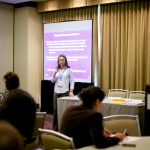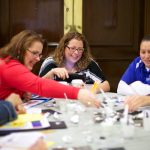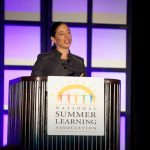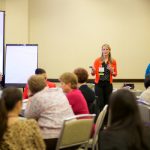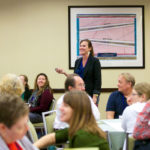
Big ideas in education hit Pittsburgh’s National Summer Learning Association Conference
Big ideas for fixing the ‘summer slide’ hit Pittsburgh’s National Summer Learning Association Conference
Before The Hunger Games was a hit movie and so widely known, Sarah Pitcock remembers visiting a California middle school that had based its summer learning program on the future society depicted in the trilogy.
“I was a little skeptical about a book about killing children being a summer learning theme,” Sarah Pitcock told a crowd of teachers gathered at the National Summer Learning Association (NSLA) conference in downtown Pittsburgh Oct. 22-24. “I could not have been more blown away.”
Teachers played residents of the Hunger Games‘ capital city, wearing the wigs and speaking in the affected manner of the books’ city dwellers. Students played the inhabitants of the book’s 12 districts. There were reapings from different districts every day, in which tributes were chosen at random — to answer reading comprehension questions and earn prizes for their district. Each district went head to head in Hunger Games quiz shows. There was even a Hunger Games dance off.
Once parents arrived with their kids on the first day, said one teacher at the conference who had participated in the program, “the parents didn’t want to leave, because they saw how cool it was going to be. It really holds the students accountable” — academically — “if they are going to be chosen at random to represent their district.”
The books were also used as the basis for discussions of social issues, such as class and race. “They were really hungry to read,” said Pitcock, senior director of program quality for the NSLA, who with the NSLA’s Director of Professional Development Peggy Espada visited more than 60 such programs around the country this past summer. “They were sneaking into the classroom to try to take the book home.”
Any good book provides a great setting, characters, culture, conflicts and resolutions for a summer learning program to be built around, Pitcock said. Pitcock saw books inspire the children of current immigrants to play — and learn about — immigrants arriving at Ellis Island in the early 1900s. In Georgia, a summer program used the books of local authors, alongside visits to their homes, to show students that they could turn into writers, too.
Game-changing summer learning programs come in all shapes and sizes, and more than 500 educators, as well as representatives from community groups that aid the nation’s schools, came to Pittsburgh to exchange ideas and learn best practices from national experts at the conference.
Among the other summer programs Pitcock and Espada offered as game changers:
- The Springboard Collaborative in Philadelphia, a K-3 reading program for kids falling behind in reading level, includes parent workshops run by teachers. Seventy-six percent of kids met or exceeded the program’s reading goals that summer, and 91 percent of parents had perfect attendance — perhaps because that was the only way their kids could receive a free laptop at the end. But the true value was in parents learning how to help their kids read: “They heard what it’s like when their child finds a just-right book,” said Pitcock.
- Global Kids, in New York City public schools, offers students the chance to Skype with a programmer of Second Life in Scotland, who helped them create a Second Life U.N. to debate world ecological issues via their avatars.
- Project Exploration, in Chicago, gives kids the chance to envision and create changes in their city. One Chicago Public Library educator at the NSLA conference saw a high-school student Photoshop a public garden onto a picture of a vacant lot next to his home. Then-Mayor Richard M. Daley was visiting the library that day, spied the photo and offered funding for the project on the spot.
- The Providence After School Alliance in Providence, Rhode Island connects kids to a caring adult and aims to increase their interest and competence in STEM (science, technology, engineering and math) skills in the fall. But the game changers, Pitcock said, are the collaboration and co-planning between teachers and community organizations — something all too rare in summer learning programs, she added.
- Many programs use rallies and ceremonies to great effect, including one in New York Pitcock observed. “It started with this competition between the boys and girls at the morning rally,” she said. “The spirit carried throughout the day.”
- At Camp Fiver for New York City public school students, each student chooses a character trait he or she is going to work towards. Completion of the program earns each kid a dog tag stamped with the attribute. “They are so proud to show they have earned these in summer after summer,” Pitcock said of participants. “Any sort of system of recognition is so valuable to retaining them.”
Pittsburgh area educators take part
Pittsburgh was well-represented at the conference. Tosha Brown, recreation leader in program development in Pittsburgh Citiparks Special Programs, said the event taught her “the importance of creating a unique culture that the [summer learning] participants feel that they belong to … The idea of ‘summer culture’ was an eye-opener for me, a very inspiring idea for building community and engaging youth voice …”
“Given how strongly the research correlates lack of summer learning opportunities with the ‘summer slide’ in literacy and math …” said another conference attendee, Cathy Lewis Long, executive director of The Sprout Fund, “it is essential that we support new strategies to engage youth in summer learning opportunities that will reduce the achievement gap.”
“Listening to the unique opportunities that various summer learning programs offer children to explore topics in an authentic way,” added Christine Cray, project manager for the Summer Dreamers Academy at PPS, “cemented my belief that summer is a time for kids to engage in real-world experiences that reinforce academic skills while also teaching them to love learning.”
Keynote speaker Sandra M. Alberti of Student Achievement Partners, who has developed statewide educational standards and policies for New Jersey, told the crowd that finding quality summer curricula among the huge quantity of offerings isn’t easy for school districts. “Quality isn’t a logo, it isn’t a stamp, it isn’t a sales pitch,” she noted. “There is no silver bullet out there.”
RAND in midst of study: What makes programs successful?
Figuring out what works, how it works and how to shift away from less successful strategies is a tough task. Pittsburgh’s RAND Corporation Senior Policy Researcher Catherine Augustine told the conference that RAND is in the midst of a five-year study of six urban districts’ summer programs for kids between third and fourth grades, in an attempt to answer many important questions: “Are these programs really having an academic impact on children? How long do these impacts last?”
Surprisingly, according to Augustine, students are just as happy in largely academic programs as they are in programs that emphasize recreation and play. Not as surprisingly, attendance at programs close to a child’s school is better than attendance when summer programs are held at a few centralized locations in a district.
While RAND won’t have data on summer programs’ effects until 2016, Augustine says the company has pinpointed a few major faults common to summer learning programs:
- Enrichment instruction, such as dance or tennis, is too often watered down by academics and vice versa. Augustine witnessed one program that asked kids to dance out weather patterns they had learned that day in the program’s science component. As a result of this curious assignment, they learned nothing extra about either moonwalks or cold fronts.
- “Many districts planned at the last minute [or] in some cases they couldn’t hire teachers in time for the training,” she noted. Other schools don’t train teachers on the summer curricula at all.
- Some districts, hiring by seniority, end up with teachers who have not recently taught the students’ grade level.
“We are not seeing effects unless kids are attending at least 80 percent of the time,” Augustine reported.
“Students are struggling during the school year, then we’re bringing them in for the same stuff,” one teacher attending the conference volunteered. “It does feel a little like we’re torturing them.”
One solution is to make sure kids believe “it’s not school, it’s camp,” said another educator in attendance, whose summer program explored everything from cooking different cuisines to understanding geometry by constructing leaning towers of popsicle-stick Pisas and fishing for lobsters — really inch-long crawfish — in a local creek. “There was not a textbook in sight,” he said. “There was not a worksheet in sight. We started with: It has to be fun. It has to be engaging. It has to be physically active.” But he was still somewhat uncertain about his program’s full effect. When the kids learned to wash and dry dishes and glassware after their Italian meal: “Was it curriculum? Was it learning? Hell if I know,” he said.
Nicole Bosworth, literacy consultant for the Scholastic Classroom and Community Group of Denver, told the teachers what they likely already realized: that the achievement gap is increased when students don’t read each summer, and that the situation is worse for lower-income students, who may not have access to kids’ reading material at home.
“Voluntary summer reading programs can work, but we know they are more effective when parents are involved” Bosworth said — and when they know how to model reading behavior and how to get their youngsters to interact with the stories.
Boston’s model for success
One city that believes its summer program is on the right track is Boston, where the Boston After School & Beyond (BASB) program was put in place in 2010 and now serves 1,600 students in grades 3-12 from 40 Boston Public schools, with 17 community organizations as partners.
“Boston is a very rich place to live but not everybody is taking advantage of Boston’s richness equally,” said Rahn Dorsey, evaluation director of the Barr Foundation, the program’s main funder. “Disparity lives in Boston in about 10 Zip codes. What is experienced there is not only the economic gap but also the opportunity gap. [Summer] didn’t seem like the most obvious place to start this work. But summer was one place where we thought we could get some major impact quickly.” The goal was to put in place “a system of rigorous fun. We’re trying to make sure that summer is not the school year. We’re also treating summer as a lever for reforming the school year.”
The students in BASB are taken out of their neighborhoods for programs on the city’s harbor islands, parks and boats. Melissa Partridge with the Boston school district notes that the program works when the community groups make sure their activities contribute to learning. “We had to match [community groups] with schools they had never met before, and it’s been the most beautiful thing,” Partridge said. “I really am seeing year-round relationships built from that.”
Although the district doesn’t yet have data on the program’s academic impact, “we are looking at establishing new school models,” said Dorsey. “I’m proud to say the city has been activated in a way it’s never been activated before.”
Photos by Bridgett Kay Harbaugh, courtesy of the National Summer Learning Association. From top to bottom: Nicole Bosworth, Catherine Augustine, NSLA attendees, Sandra Alberti, Sarah Pitcock and Peggy Espada.
